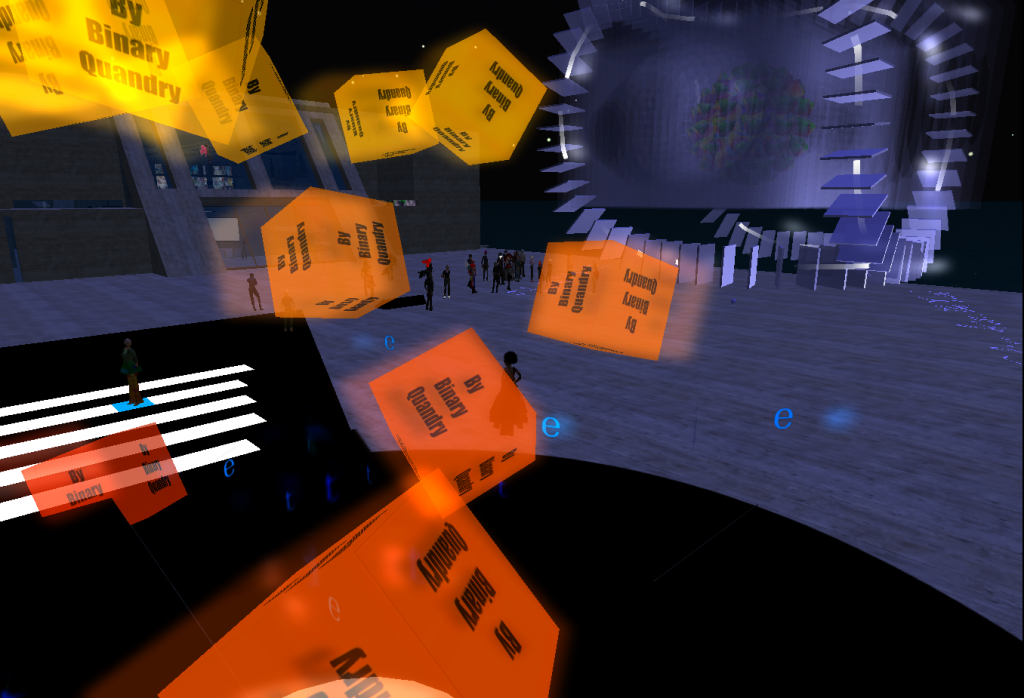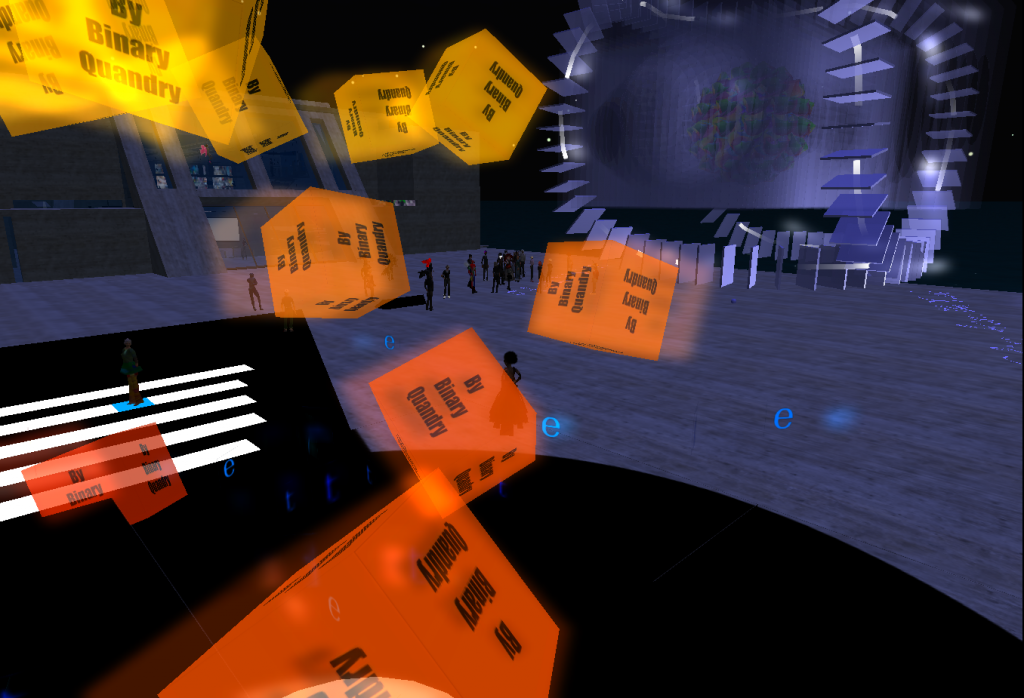Solkide Auer, Shellina Winkler, and Binary Quandry are Second Life artists who are part of the Pirats Art Network, a partner and major contributor in the Through the Virtual Looking Glass exhibition.
[youtube:https://www.youtube.com/watch?v=-ek1qQB98NI]
I wrote about Pirats in my introductory blog post earlier this week and I will close my series with wisdom from founders Newbab Zsigmond and Merlina Rokocoko of Pirats and the much-quoted theorist Georg Janick from the Virtual Arts Initiative. Most of the virtual 3D art in Through the Virtual Looking Glass is immersive. It is made up of 3D objects called prims (in SL) that can be coated in moving video, or accompanied by densely layered sounds. The latest version of the Second Life viewer features HTML On A Prim, linking prims to live webpages, Flash movies, and more.
Artists have attempted to create the illusion of distance and depth on a flat surface since the early fifteenth century. Realities, other than the material world we live in, have existed for centuries. In essence, what defines human consciousness is the ability to imagine other “realities,” starting with the nuances such as sound, inflection, pauses, gestures, and other subtle signs. In virtual 3D worlds, these feelings create varying levels of emotional bandwidth. In other words, art in virtual 3D worlds can activate real emotions.
The feeling of being part of an artwork, in a perceptually immersive 3D space is very much akin to the feeling of being on a carnival ride, minus certain degrees of emotional bandwidth. Immersive 3D artworks often simulate the real life experience of being in material space. You lose your critical distance to the experience and get emotionally involved. You feel as if the art is very real but know it is not.
[youtube:https://www.youtube.com/watch?v=tA537cM4j14&feature=player_embedded]
The definition of immersion is broad but here it means that the visitor feels like he or she is part of the simulated art “universe.” Dr. Gary Zabel (Georg Janick in SL) defines immersion as,
The experience of being enveloped by a surrounding environment, (similar to) what the Germans call an Umwelt. Without immersion there would be no virtual worldhood at all, but rather reception of an image external to the viewer.
I recall feeling physically dizzy after my avatar emerges from “trippy” virtual art installations. I’ve experienced illusions and changes of perception even though it is my avatar that participates in the activity. René Magritte was a 20th-century artist whose work still challenges the observer’s perception of reality and forces the viewer to become more aware of his/her environment. In Second Life, several artists have re-created Magritte’s 2D artworks. Regarding Magritte’s Time Transfixed, SL artist Blue Tsuki writes,
René Magritte practiced a particularly elegant flavor of surrealism that influenced me long ago and resonates to this day. I chose this particular image not only because it is one of my favorites, but also because it exemplifies that simplicity of strange non-sequitur that distinguishes his work. I also felt this image would translate well into 3D. It was a pleasure to manifest.
You can see more examples of prim’ed art at Primtings Museum in Second Life. From the homepage of the website:
Primtings is a prim’d paintings gallery. We are a museum dedicated to the interactive exploration of famous paintings and artwork brought to virtual life via 3D prims and other techniques.
Solkide Auer’s homage to M.C. Escher’s Relativity is also part of the Primtings’ virtual 3D art collection in Second Life. Solkide writes,
I’ve always loved Escher’s creations for the strong emotions I felt in admiring his works. Creating 3D Relativity in SL has been a way to thank him for the enthusiasm he injected into me. I’d like to dedicate my work to him, to his modernity and his ability of showing objects in a visionary way. He was surely aware that one day, technology would be able to complete the work he created decades before. I created Relativity by using the simple elements of “build,” shaping every piece one by one without using any script. It can be defined as a handmade work.
Solkide Auer and his Second Life art collaborator, Shellina Winkler, are both from Italy and they have been working in SL since 2007. They were more than accommodating when I visited their online sim (simulation) and virtual art gallery, Italic’Art.
[youtube:https://www.youtube.com/watch?v=hHggadFoO0A]
Prior to the interview, I visited their current installation, Colors from the Void, on display at the first international mixed reality art exhibition, Through The Virtual Looking Glass. Here is the transcript of the interview:
Nettrice Gaskins: What inspires you/your work?
Shellina Winkler: Sometimes we start with a shape, a color, a theme, or what fantasy suggests to us. In the last period, we’ve been working mainly on immersive works. We took part in the last two editions of Burning Life. You can see some images from that in the screens behind us. Interaction is our first aim, as well as curiosity.
NG: How did Colors from the Void come about?
Solkide Auer: When we work around an idea, generally we know that the work will mainly be seen in SL, so we create artwork for avatars to see and enter into. This time, for Colors, we had to work in a different mode. Through the Virtual Looking Glass is an exhibition for people of SL and also for people of RL (real life).
NG: Do you each have a favorite work?
SW: I’ve passed through many phases as an artist in SL and I’ve got one for sure that is my favorite. It’s called Second Star to the Right. It was born during a very special creative moment for me and it had the fortune to be exposed both in SL and in RL. In was exhibited in Florence, in the summer of 2008. While I was creating Second Star, I fancied a sort of trip towards a magical place and it has a peculiarity. If you fly close, you can sit on it and at the first opening, more than 20 people succeeded in sitting on it.
[youtube:https://www.youtube.com/watch?v=QxV4DmCAQno]
SA: I have many favorites, but 3 are the most representative of me. The first is the work I dedicated to M.C. Escher (see Primtings work above) and it’s called The King of Impossible. If you click on the red panel, you can have a special sit. As you have seen, I have tried to represent in 3D a work originally created in 2D paint.
NG: Why is this work significant?
SA: Mmm. The fact that today it is possible to make things that 100 years ago were impossible to be made, just imagined. The next work is called Radiazioni. If you look around with camera, you see a special optical effect.
SA: This work is one of my first to be exhibited in a major Second Life museum. It’s typical of artwork that is so called “impossible in RL.” If you want, I can let you see my third preferred work. [After removing Radiazioni and rezzing a new piece.] Do you know this man next you?
NG: It’s Popeye!
SA: Look around with camera and you will discover another special effect: a black line. It’s a particularity of this work that is usually seen in 2D pictures.
NG: Like in comic books?
SA: Exactly. I created it with no scripting. It’s all hand-made in SL.
SW: I’ve been working several immersive artworks. I can show you some of them if you like.
NG: Great. Lead the way!
[youtube:https://www.youtube.com/watch?v=lLtAtcgSzXI]
While documenting Shellina and Solkide’s work, I noted that once the senses believe that an immersive environment is real, the visitor must then be able to interact with the environment in a natural, intuitive manner. SL artists are always searching for new ways to do this. They are incorporating a variety of new media and special effects that respond to the user’s actions and movements. Another of Gary Zabel’s aesthetic-technological dimensions is interactivity. He writes,
Interaction is the experience of exerting influence on and being influenced by objects in the virtual world. Like immersion, interaction is a necessary condition of virtual worldhood, since, if we were unable to engage with virtual objects in this fashion, we could not be said to dwell along with them. But dwelling along with other things, and so sharing a common context, is part of what it means to inhabit a world.
[youtube:https://www.youtube.com/watch?v=kNHmxaWZc24&feature=PlayList&p=95CF1FDCCD8D878C&playnext_from=PL&playnext=1&index=31]
SL artist Binary Quandry makes interactive virtual art and uses the avatar’s key identifier (similar to a online fingerprint) to produce visual effects. Binary writes,
I do two types of virtual art, sculptures and installations. Reactive in the sense that I always use either collision or sensors (automated avatar influence) in my works. In addition, I also include sound, music and video in some of my works.
The primary principle in my works is the avatar key, a unique identifier. All avatars (and other items) in Second Life have a unique identifier; similar to a fingerprint in the physical world.
Based on the avatar key, I define the appearance and behavior of the sculpture or installation, such as color, shape, animation and position of objects. Recently, I have worked with applying very basic principals from genetics (mutation and recombination).
From a general point of view, I would say immersions are the changes that happen in with the works when avatars are nearby, thus, changes in the very local environment.
In my future works, the new shared media opportunities with the new viewer too will play a significant role. I am heading towards a more “true” multimedia experience with video, sound, and music to be included in future installations. I will probably also use principals of genetics together with the avatar key more often.
This wraps week one (of two) of my guest blogging stint for Art21 and what a experience this has been! These posts have enabled me to make new connections with artists, many who are from geographical locations across the globe, and speak a variety of languages. Some are theorists. Some are established artists of their own right in real life. Others create art exclusively in Second Life or on the Reaction Grid and have managed to create a niche for themselves as part of the vanguard of a new art movement. I am glad to have an opportunity to write about these artists and share their efforts here.

